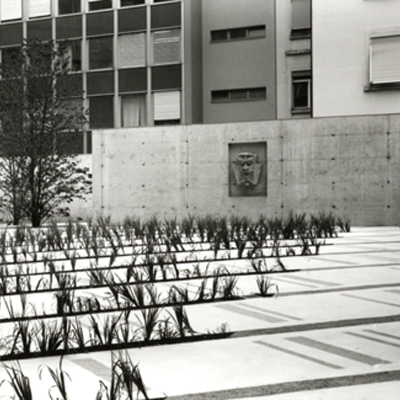
DOCTORAL STUDENT
Anette Freytag
ADVISOR
Professor Christophe Girot
CO-ADVISORS
Prof. em. Arthur Rüegg, Prof. Dr. Philip Ursprung
PROJECT TIMEFRAME
Completion: 2011
PUBLICATION
Edition gta, Zurich, October 2015
Designing Nature. About the work of Swiss Landscape Architect Dieter Kienast (1945-1998)
The dissertation presents the first comprehensive critique of the work of Dieter Kienast and covers the period from the 1970’s to the 1990’s. It intends to show to what extent Kienast developed a new aesthetics for designing with nature in the city through his investigation in methods of plant sociology and his research on spontaneous vegetation in the city that he started at the Gesamthochschule in Kassel. It is further shown how he was able to go from a study and interpretation of urban spontaneous vegetation to making his work legible through an emblematic and symbolic use of plants.
Upon returning to Switzerland from Kassel, Kienast confronted and opposed the wildlife gardening movement that influenced Swiss garden and landscape architecture with his concepts based on form. The question of the suitability for daily use of his increasingly form-driven open spaces, which culminated in the 1990’s and is always mentioned by his critics, is put in a new perspective when one reflects on his roots in Kassel. In the dissertation Anette Freytag argues that Kienast consummated a modification of the emancipatory design paradigm of the Kassel School in his later works – from practical to contemplative use, from daily life to aesthetic experience – while the subject-related focus remained constant. Kienast’s position in a cultural historical context is therefore ambivalent: Regardless of the extent to which he clearly uses sometimes strikingly postmodern techniques, he
The dissertation presents the first comprehensive critique of the work of Dieter Kienast and covers the period from the 1970’s to the 1990’s. It intends to show to what extent Kienast developed a new aesthetics for designing with nature in the city through his investigation in methods of plant sociology and his research on spontaneous vegetation in the city that he started at the Gesamthochschule in Kassel. It is further shown how he was able to go from a study and interpretation of urban spontaneous vegetation to making his work legible through an emblematic and symbolic use of plants.
Upon returning to Switzerland from Kassel, Kienast confronted and opposed the wildlife gardening movement that influenced Swiss garden and landscape architecture with his concepts based on form. The question of the suitability for daily use of his increasingly form-driven open spaces, which culminated in the 1990’s and is always mentioned by his critics, is put in a new perspective when one reflects on his roots in Kassel. In the dissertation Anette Freytag argues that Kienast consummated a modification of the emancipatory design paradigm of the Kassel School in his later works – from practical to contemplative use, from daily life to aesthetic experience – while the subject-related focus remained constant. Kienast’s position in a cultural historical context is therefore ambivalent: Regardless of the extent to which he clearly uses sometimes strikingly postmodern techniques, he
Lectures on Dieter Kienast’s work and its context by Anette Freytag
2014
10.4. 18.30h
Timothy E. Lenahan Memorial Lecture 2014, Hastings Hall, Yale School of Architecture, New Haven
Back to the Roots: Topology and Phenomenology in Landscape Architecture
4.11. 16.00h
Guest Lecture, ČVUT – Czech Technical University, Faculty of Architecture, Prague
Dieter Kienast- Science and Memory in Landscape Architecture
2013
20.6. 14.25h
Conference: Thinking the Contemporary Landscape. Positions and Oppositions, Herrenhausen Palace, Hanover
Dieter Kienast and the Heritage of the Topological and Phenomenological Dimension of Landscape Architecture
2012
23.4. 18.15h
PHD Talks, ETH Zürich-Hönggerberg, HIL D25.9
Methodik, Inhalt und Aufbau der Dissertation zu Kienasts Werk
29.4. 11.30h
Hallen für Neue Kunst in Schaffhausen
Landschaft-Kunst-Landschaftsarchitektur. Sensorien für Mensch und Raum seit den 1960er Jahren.
A public guided tour
7.5. 19.30h
Architektur Forum Ostschweiz
Ein Vokabular für die Landschaft. Dieter Kienast und die andere Postmoderne
11.5. 8.00h
ETH Zürich-Hönggerberg HIL E 3
Bildverlust. Zur kritischen Aktualität von Landschaft (mit Albert Kirchengast)
12.5. 15.00h
Freisinger Gartentage
Über den letzten Luxus unserer Tage: Gärten und Freiräume von Dieter Kienast
15.6. 14.00h
Ecole Nationale Supérieure d’Architecture de Versailles
Le passage de l’écologie au modèle régulier dans l’œuvre du paysagiste Dieter Kienast
27.06. 18.15h
Zentralinstitut für Kunstgeschichte, München
Vergabe des Theodor-Fischer-Preises 2012 für herausragende Forschungsarbeiten zur Architekturgeschichte des 19. und 20. Jahrhunderts an Anette Freytag für ihre Dissertation: “Natur entwerfen – Zum Werk des Schweizer Landschaftsarchitekten Dieter Kienast (1945-1998)”
11.7. 18.15h
Zentralinstitut für Kunstgeschichte, München
Die Natur der Stadt – Dieter Kienasts Beitrag zu einer neuen Ästhetik in der Landschaftsarchitektur
15.11. 19.00h
Villa Sträuli, Museumstrasse 60, Forum Architektur Winterthur
Engagement und Schönheit – Die Landschaftsarchitektur von Dieter Kienast (1945-1998)

